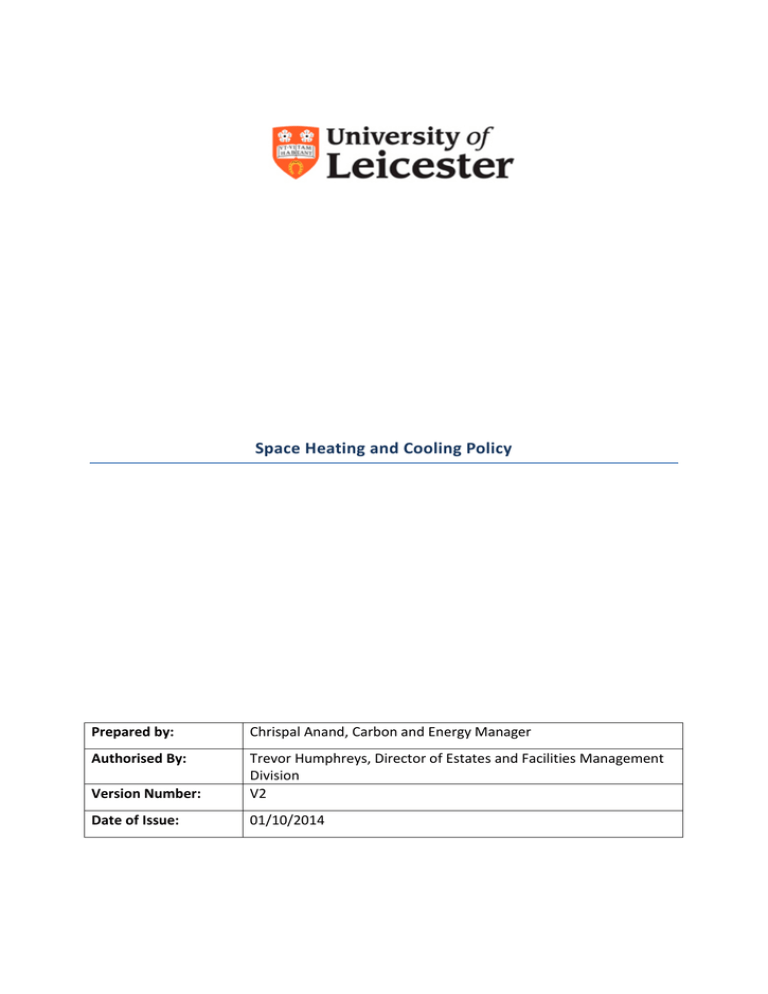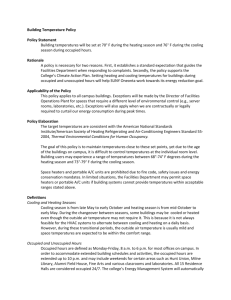Space Heating and Cooling Policy
advertisement

Space Heating and Cooling Policy Prepared by: Chrispal Anand, Carbon and Energy Manager Authorised By: Version Number: Trevor Humphreys, Director of Estates and Facilities Management Division V2 Date of Issue: 01/10/2014 The Aim of the Policy The University of Leicester aims to provide and maintain a thermal comfort level temperature of between 16oC and 21oC throughout all areas during the heating periods in non-residential space. The residential areas shall be maintained between 20oC and 22oC. The University also aims to ensure appropriate cooling methods are provided for research purposes and undertake all practical measures to avoid the need for comfort cooling. Purpose of the Policy By implementing this Policy, the University commits to providing suitable thermal comfort to its building users and provision of low impact process cooling for research purposes, thereby reducing its capital and on-going energy cost and considering its carbon emissions reduction target of 60% by 2020. Responsibility for Policy Implementation The Director of Estates shall retain the responsibility to extend and/or reduce the heating period at the non-residential and residential sites. Where cooling is required, the Director of Estates shall consider for approval a business case for cooling, taking into account the energy and carbon cost implications and 2020 carbon reduction target. Recommended Temperatures Based on Chartered Institution of Building Services Engineers (CIBSE) 1 guidelines, the different types of buildings/areas are designed to operate at temperatures between 19 and 21oC. Legal Guidance on Heating In 1992, the Workplace (Health, Safety and Welfare) Regulations were published dictating particular requirements for the working environment 2. In particular, Regulation 7 under the Workplace Regulations deals with temperature in workplaces and states, “during working hours, the temperature in all workplaces inside buildings shall be reasonable”. The Approved Code of Practice provides guidance to the Regulation by stating “the temperature in workrooms should normally be at least 16 degrees Celsius unless much of the work involves severe physical effort in which case the temperature should be at least 13 degrees Celsius”. What is Thermal Comfort? Thermal comfort is very difficult to define because of a range of environmental and personal factors that need to be taken into account when deciding on the temperatures and ventilation rates that make individuals feel comfortable. The best that can be realistically achieved in any situation is an environment, which satisfies the majority of people. The Health & safety Executive (HSE) considers 80% of occupants as a reasonable limit for the minimum number of people who should be thermally comfortable in an environment. The HSE provides further guidance on thermal comfort in the 1 Chartered Institute of Building Services Engineers Guide, Volume A ‘Design Data’, Page A1-5 Table A1.3. Workplace (Health, Safety and Welfare) Regulations 1992 and Approved Code of Practice and Guidance L24 (Second Edition) dated 2013, 2 workplace 3. What Heating Temperature is the University Working Towards? The Maintenance Team in the Estates and Facilities Management Division (EFMD) shall aim to maintain 19oC in non-residential areas unless there is a requirement for a particular set of temperatures for research purposes or specific activities. Removal of Unapproved Temporary Portable Heaters and A/C Units To comply with health and safety, all temporary heaters and A/C units used at the University are to be PAT tested. Only approved heaters shall be used which will be oil filled radiators. Other types of heaters may pose significant fire risks. The Maintenance Team at the EFMD may remove other temporary heaters if they are not officially authorised. Temporary heaters and A/C Units will be issued only through Head of Planned Maintenance following formal requests. Heating Periods Academic and related areas: Normal heating hours are optimised to be at working temperature between 8.00am to 6.00pm, Monday to Friday, from 1st October to 1st May inclusive. Heating will normally be switched off between 1st May to 30th September to help maintain comfort to staff and students and to reduce the carbon impact as a result of space heating. The heating season may be extended for periods between May to September if there are 2 consecutive days or more, where the outside daytime temperature does not rise above 16oC. However, if internal temperatures are below the legal minimum, we will endeavour to provide supplementary heating. The heating season may be reduced during March to May if there are periods of high temperatures i.e. periods of 2 consecutive days or more where the outside temperature is above 20oC. Out of hours heating at the University is provided to study areas within the Library and in scheduled lectures theatres/timetabled space for use outside the working hours given above. Restaurant, Food outlets and bar areas: As per advertised opening hours. Library: As per advertised opening hours. Students’ Union: As per advertised opening hours. Student residential accommodation: Autumn and spring term heating optimised to be at working temperature from 7.00am to midnight, Sunday to Thursday, and 7.00am to 2.00am Friday and Saturday. The summer term heating optimised to be at working temperature from 8.00am to 2.00am seven days per week. Laboratory conditions remain outside this protocol. Procedure for Cooling: The University shall provide cooling only for research purposes and for specific activities where cooling is required to maintain/control certain temperatures and humidity. The University does not provide comfort cooling. Any additional cooling shall be business cased and approved by the Director of Estates. The initial cooling assessment sheet (provided by EFMD) shall be completed and submitted to the Deputy Director of Estates for further consideration. 3 Thermal comfort in the workplace: Guidance for employers HSG194 HSE Books 1999 ISBN 0-7176-2468-4. The business case should specify: • • • demonstration/modelling of consistently unacceptable temperatures. an explanation of how other design solutions e.g. shading, mechanical ventilation, energy efficiency of IT 4 and lighting or changes to layout are insufficient, relocation of operation/equipment. whole life costs (including energy and maintenance costs 5) and carbon emissions over a period of 15 years. • All submitted cases shall be dealt with based upon their individual merits with the final decision based upon a sound technical, financial and pragmatic case. Expectations of all Building Users All building users shall be responsible for: • • • • Keeping the heat in the building by closing windows and doors as appropriate. Ensuring that radiators are not blocked with furniture, clothing etc. Reporting any faults and areas where there are over or under heating to the Estates Maintenance Help Desk (x5851/maintsystem@le.ac.uk). Wearing suitable clothing(s) in hot and cold weather. Expectation of the Estates and Facilities Management Division • • • • • • • The extending or shortening of the heating season shall be determined based on weather conditions and this shall lie with the Director of Estates. The responsibility for reducing excessive space heating temperatures in milder weather shall lie with the Head of Operations and the Carbon and Energy Manager. Co-ordinating Policy shall be the responsibility of the Carbon and Energy Manager and Head of Planned Maintenance, supported by the Building Contacts. Investigating complaints shall lie with the Estates Help Desk (x5851/maintsystem@le.ac.uk), led by the Head of Planned Maintenance and Maintenance Team, who shall respond accordingly and provide suitable feedback within two working days. Temperatures shall be controlled using engineering solutions such as Building Management Systems (BMS), or modifying processes where necessary, etc. To prevent dehydration in the workplace where temperatures cannot be reduced, mains drinking water facilities will be provided where feasible. Where temperatures cannot be achieved during the heating season, electric heaters shall be provided. On safety grounds, electric heaters other than those issued by the EFDM are prohibited for use throughout ALL University properties. Evaluation of the Policy The EFDM shall monitor the efficiency of this Policy by continually monitoring energy consumption in conjunction with this policy, which shall be reviewed annually. 4 The optimal design of server rooms to allow increased air-flow in accordance with manufacturer’s specifications should, in many cases, remove the requirement for A/C entirely. 5 Where air conditioning is specified and approved, it is recommended that the operational set point for cooling ° should be targeted at 24 c to avoid excessive cost of operation although it is recognised that this may have to be higher in certain circumstances. Further Information For further information on this policy, please contact the Planned Maintenance at the Estates and Facilities Management Division. Carbon and Energy Manager – x2308/carbon@le.ac.uk Maintenance – x2319/maintenance@le.ac.uk

